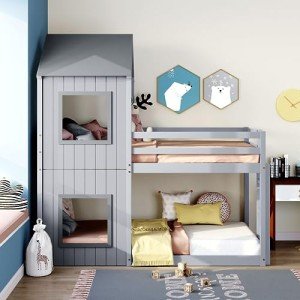12 Facts About Bunk Beds To Make You Take A Look At Other People

Exploring Bunk Beds: A Comprehensive Guide
Bunk beds have long been a staple in kids's bed rooms, dorms, and even homes with limited space. Not just do they supply a useful sleeping service, however they likewise develop a fun and imaginative environment for children and a great space-saver for adults and households. This article will explore whatever you need to know about bunk beds, from types and products to security pointers and buying advice.
Tabulation
- Kinds Of Bunk Beds
- Standard Bunk Beds
- Loft Beds
- Triple Bunk Beds
- L-Shaped Bunk Beds
- Product Options
- Wood
- Metal
- Safety Considerations
- Purchasing Guide
- Frequently asked questions
Kinds Of Bunk Beds
Bunk beds come in different designs to fit different needs and choices. Here's a breakdown of the most typical types:
Conventional Bunk Beds
Traditional bunks typically feature two beds stacked vertically on top of one another. These beds are ideal for brother or sisters sharing a room or for maximizing sleeping space in visitor rooms.
Loft Beds
Loft beds stand similarly to standard bunk beds however do not have a lower sleeping area. Instead, they typically incorporate a desk or seating location beneath, making them a great choice for small spaces needing multifunctionality.
Triple Bunk Beds
Triple bunk beds are created for three occupants, with beds stacked in a three-tier setup. These are less common however can be an enjoyable option for big families or sleepovers.
L-Shaped Bunk Beds
With one bed positioned horizontally and the other vertically, L-shaped bunk beds are frequently geared up with additional functions such as desks or storage drawers and can complement corner spaces in a space.
Contrast of Bunk Bed Types
| Bed Type | Perfect Use | Description |
|---|---|---|
| Traditional | Shared bed rooms or guest rooms | 2 beds stacked vertically |
| Loft | Little spaces requiring multi-purpose space | Upper bed with open space below |
| Triple | Large families or sleepovers | 3 beds stacked vertically |
| L-Shaped | Corner or versatile spaces | A mix of vertical and horizontal beds |
Material Options
Bunk beds are produced from different products, with wood and metal being the most common. Each product has its benefits and drawbacks.
Wood
- Resilience: Generally robust and can stand up to years of use.
- Visual Appeal: Offers a classic look that can blend with various decors.
- Weight Capacity: Typically sturdier; can support much heavier weights.
- Disadvantages: May be more costly than metal choices and can be prone to scratches.
Metal
- Toughness: Generally light-weight and easy to move however still tough.
- Modern Design: Often is available in streamlined designs, making it appealing for modern spaces.
- Cost-Effective: Usually cheaper than wooden options.
- Downsides: Can be cold to the touch in winters and may not have the exact same aesthetic appeal for some buyers.
Security Considerations
When it concerns bunk beds, security can not be overlooked. Here are key security ideas to keep in mind:
- Guardrails: Ensure that the top bunk has guardrails on both sides to prevent falls.
- Sturdy Construction: Check for a solid build and strong products to endure weight and movement.
- Weight Limit: Adhere to the manufacturer's weight limit for both the upper and lower bunks.
- Ladder Design: Choose bunks with a safe, easy-to-climb ladder and avoid any sharp edges or rungs.
- Age Restrictions: Most makers recommend that kids under the age of six need to not oversleep the upper bunk.
Buying Guide
When shopping for bunk beds, think about the list below aspects to discover the best suitable for your requirements:
- Space Availability: Measure the space size and ceiling height, guaranteeing there is adequate space for the leading bunk.
- Bed Size: Decide in between twin, complete, or bigger sizes based on your requirements and the size of the room.
- Style Preference: Consider the total design of the bedroom to find an ideal design.
- Reduce of Setup: Look for a bunk bed that is simple to put together.
- Budget: Bunk beds can be found in different price varieties, so figure out a budget before beginning your search.
FAQs
1. What is Bunk Beds Sales recommended age for children to sleep on the leading bunk?
Kids aged 6 and older are typically suggested to sleep on the top bunk to reduce the danger of falls.
2. How can I make my bunk bed more secure?
To enhance safety, make sure guardrails are effectively set up and examine that the bed is put on a flat surface. Additionally, motivate children to utilize the ladder carefully.
3. Can I transform a bunk bed into two different beds?
Many bunk beds are designed to be convertible. Check the manufacturer's specifications for convertibility functions.
4. What accessories are available for bunk beds?
Common accessories include beddings, storage drawers, staircases instead of ladders, and tented canopies for a fun visual appeal.
5. How do I maintain my bunk bed?
Regular checks for loose screws or structural stability can help guarantee security. Dust the bed regularly and clean spills promptly to keep the products in good condition.
Bunk beds are versatile and a space-efficient option for various living situations, from kids's rooms to visitor lodgings. With lots of styles and products readily available, potential buyers have a wealth of choices to consider, ensuring a combination of functionality and visual appeals. By focusing on safety and following the tips described in this guide, people can discover the ideal bunk bed that suits their space and way of life, all while developing a pleasurable sleeping environment.

